
XXXVI Simpósio Brasileiro de Telecomunicações e Processamento de Sinais
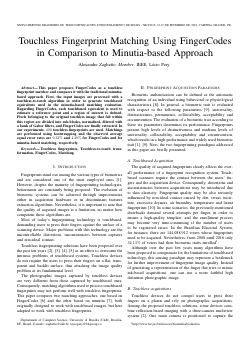
Touchless Fingerprint Matching Using FingerCodes in Comparison to Minutia-based Approach
Alexandre Zaghetto, Lécio Pery
DOI: 10.14209/sbrt.2018.116
Keywords: Touchless fingerprints Touchless-to-touch transformation FingerCodes Matching
Abstract
This paper proposes FingerCodes as a touchless fingerprint matcher and compares it with the traditional minutia- based approach. First, the input images are processed with a touchless-to-touch algorithm in order to generate touchbased equivalents used in the minutia-based matching evaluation. Ragarding FingerCodes, each touchbased equivalent is used to estimate a reference point and a region of interest is defined. Pixels belonging to the original touchless image that fall within this region are divided into sub-blocks, normalized, filtered with a bank of Gabor filters, and FingerCodes are finally extracted. In our experiments, 400 touchless fingerprints are used. Matchings are performed using bootstrapping and the observed average equal error rates are 9.32% and 4.29% for FingerCodes and for minutia-based matching, respectively.Download
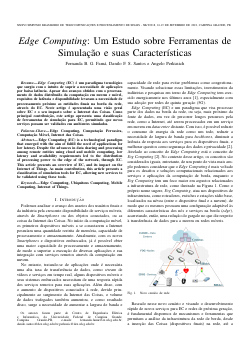
Edge Computing: Um Estudo sobre Ferramentas de Simulação e suas Características
Fernanda B. G. Fama, Danilo F. S. Santos, Angelo Perkusich
DOI: 10.14209/sbrt.2018.112
Keywords: Edge Computing Ubiquitous Computing Mobile Computing Internet of Things.
Abstract
Edge Computing (EC) is a technological paradigm that emerged with the aim of fulfill the need of applications for low latency. Despite the advances in data sharing and processing among remote entities using cloud and mobile computing, low latency and availability requirements led to the distribution of processing power to the edge of the network, through EC. This article presents an overview of EC, and its impact on the Internet of Things. As main contribution, this article presents a classification of simulation tools for EC, allowing new services to be validated using these toolsDownload
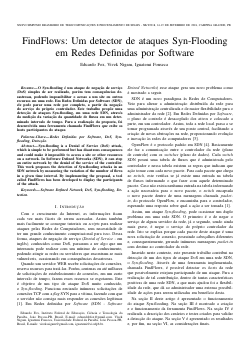
FindFlows: Um detector de ataques Syn-Flooding em Redes Definidas por Software
Eduardo Fox, Vivek Nigam, Iguatemi Fonseca
DOI: 10.14209/sbrt.2018.117
Keywords: Redes Definidas por Software DoS Syn- flooding Detecção
Abstract
O Syn-flooding é um ataque de negação de serviço (DoS) simples de ser realizado, porém tem consequências desastrosas, podendo impossibilitar o acesso a um site ou outros recursos em uma rede. Em Redes Definidas por Software (SDN), ele pode parar uma rede por completo, a partir da negação do serviço do próprio controlador. Este trabalho propõe uma detecção de ataques Syn-flooding, em uma rede SDN, através da medição da variação da quantidade de fluxos em um determinado intervalo de tempo. Para a realização da proposta, foi desenvolvida uma ferramenta chamada FindFlows que exibe os hosts participantes do ataque.Download
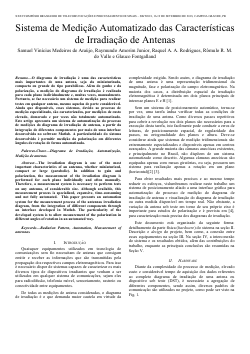
Sistema de Medição Automatizado das Características de Irradiação de Antenas
Samuel Vinícius Medeiros de Araújo, Raymundo Amorim Junior, Raquel A. A. Rodrigues, Rômulo R. M. do Valle, Glauco Fontgalland
DOI: 10.14209/sbrt.2018.118
Keywords: Radiation Pattern Automation Measurement of antennas.
Abstract
The irradiation diagram is one of the most important characteristics of an antenna, whether miniaturized, compact or large (parabolic). In addition to gain and polarization, the measurement of the irradiation diagram is performed for each plane individually and often manually. Therefore, a measurement system is necessary to perform tests on any antenna, of considerable size. Although available, this measurement process is specialized, expensive, time-consuming and not fully automated. This paper presents an automation system for the measurement process of the antennas irradiation diagram, from the integration of different components through an interface developed in Matlab. The particularity of the developed system is to allow measurement of the polarization in different angles of rotation in an automated wayDownload
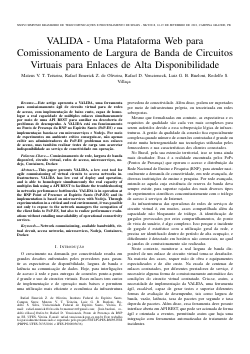
VALIDA - Uma Plataforma Web para Comissionamento de Largura de Banda de Circuitos Virtuais para Enlaces de Alta Disponibilidade
Mateus V. T. Teixeira, Rafael Emerick Z. de Oliveira, Rafael D. Vencioneck, Luiz G. B. Bueloni, Rodolfo S. Villac¸a
DOI: 10.14209/sbrt.2018.113
Keywords: Network commissioning available bandwidth virtual circuit access networks microservices Nodejs Containers Docker.
Abstract
This paper presents VALIDA, a low cost tool for agile commissioning of virtual circuits to access networks infrastructures. VALIDA has low cost of deploy and operation, and is able to homologate simultaneously the real capacity of multiples link using a API REST to facilitate the troubleshooting in networks performance bottlenecks. VALIDA is in operation at the RNP Point of Presence at Esp´ırito Santo (PoP-ES) and its implementation is based on microservices with Nodejs. Through experimentation in a critical and real environment, it was possible not only to expose to the network managers the occupation of the client links to PoP-ES, but also to realize performance evaluations without entailing unavailability of operational connectivity services.Download
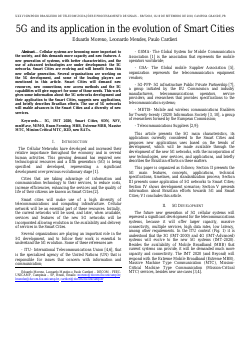
5G and its application in the evolution of Smart Cities
Eduardo Moreno, Leonardo Mendes, Paulo Cardieri
DOI: 10.14209/sbrt.2018.86
Keywords: 5G IMT 2020 Smart Cities SDN NFV mmWave MIMO Beam Forming MBB Extreme MBB Massive MTC Mission Critical MTC D2D new RATs
Abstract
Cellular systems are becoming more important to the society, and this demands more capacity and new features. A new generation of systems, with better characteristics, and the use of advanced technologies are under development: the 5G networks. Smart Cities are evolving and will benefit from this new cellular generation. Several organizations are working on the 5G development, and some of the leading players are mentioned in this article. Smart Cities will demand new resources, new connections, new access methods and the 5G capabilities will give support for some of those needs. This work gives some information about the 5G networks development and their application to the Smart Cities, suggests new applications, and briefly describes Brazilian efforts. The use of 5G networks will enable advances in the Smart Cities and a diversity of new services.Download

Extensão do Algoritmo Set-Membership-CM para o Contexto de Redes de Sensores Sem Fio
Fábio F. de Assis, Aline Neves
DOI: 10.14209/sbrt.2018.114
Keywords: Filtragem Adaptativa Autodidata Algoritmo SM-CMAD-SG Redes de Sensores Sem Fio
Abstract
O objetivo deste artigo é estudar o problema de filtragem adaptativa e apresentar solução para reduzir a interferência intersimbólica (IIS) na equalização de sinais, no contexto de redes de sensores sem fio, operando no modo difusão. Para isso, estendemos o critério de equalização cega Setmembership do Módulo Constante (SM-CM) [1] para o contexto de redes de sensores sem fio no modo difusão. O novo algoritmo é denominado Algoritmo Set-membership CMA no modo Difusão SG (SM-CMAD-SG). Com isso a rede consegue economizar na troca de informações entre os nós, reduzindo processamento e consumo de energia. Comparamos este algoritmo com o algoritmo Set-membership CMA no modo Difusão (SM-CMAD) proposto em [2]. Ainda que os dois apresentem desempenhos semelhantes em termos de redução da IIS, o novo algoritmo possui desempenho médio 50% superior ao SM-CMAD em termos de economia de energia.Download
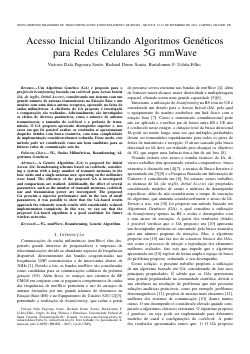
Acesso Inicial Utilizando Algoritmos Genéticos para Redes Celulares 5G mmWave
Victoria Dala Pegorara Souto, Richard Demo Souza, Bartolomeu F. Uchoa-Filho
DOI: 10.14209/sbrt.2018.99
Keywords: 5G mmWave Beamforming Genetic Algorithm.
Abstract
A Genetic Algorithm (GA) is proposed for Initial Access (IA) beamforming schemes based on codebook, considering a system with a large number of transmit antennas in the base statio and a single-antenna user, operating on the millimiter wave band. The efficiency of the proposed GA is investigated and comparisons are realized. Additionally, the effect of several parameters, such as the number of transmit antennas, codebook size and transmission power are investigated. The proposed GA presents a superior performance and, in the case of small parameters, it was possible to show that the GA-based results approach the exhaustiv search results with considerably reduced implementation complexity. In this way, we can say that the proposed GA-based algorihtm is a good candidate for future wireless networksDownload
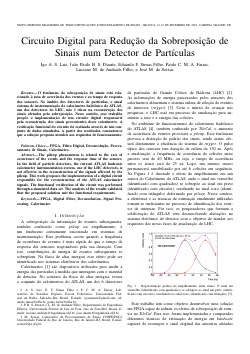
Circuito Digital para Redução da Sobreposição de Sinais num Detector de Partículas
Igo A. S. Luz, Joao Paulo B. S. Duarte, Eduardo F. Simas Filho, Paulo C. M. A. Farias, ˜ Luciano M. de Andrade Filho, Jose M. de Seixas
DOI: 10.14209/sbrt.2018.98
Keywords: FPGA Digital Filter Deconvolution Signal Processing Calorimeter
Abstract
The pileup phenomenon is related to the rate of occurrence of the events and the response time of the sensors. In the field of particle detectors, the current ATLAS hadronic calorimeter instrumentation system, one of the LHC detectors, is not effective in the reconstruction of the signals affected by the pileup. This work proposes the implementation of a digital circuit responsible for the reconstruction of the ATLAS calorimeter signals. The functional verification of the circuit was performed through a simulated data set. The analysis of the results validated that the proposed solution met the functional requirements.Download

Estudo de viabilidade do uso do RFID para rastrear EPIs no setor de Transmissão de Energia Elétrica
E. C. Moreira, Jandeildo A. da Silva, David A. Santos, A. S. B. Sombra
DOI: 10.14209/sbrt.2018.100
Keywords: Sistemas de Telecomunicações Redes sem Fio RFID Rastreamento Gerência
Abstract
Este artigo foca na análise de viabilidade do uso de identificação por radiofrequência (RFID) no rastreamento dos equipamentos de proteção individual (EPIs) de um operador de manutenção do setor de transmissão de energia elétrica. Para alcançar esse propósito, várias atividades de pesquisa e desenvolvimento foram realizas, buscando compor um cenário de aplicação da tecnologia RFID que viabilize a identificação automática desses EPIs. As atividades mencionadas consideraram diferentes posicionamentos de antenas e etiquetas inteligentes (tags). As tabelas, imagens e gráficos comparativos resumem os resultados de identificação dos itens, levando este trabalho à conclusão sobre a viabilidade da identificação dos EPIs utilizando RFID.Download